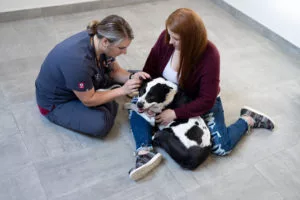
6 Signs a Dog Has Fleas
Dr. Hayley Bernal
Call & Speak with a doctor Open 24/7, Even Holidays!
Walk in today for:
Emergencies
Point-of-Care Ultrasound
Urgent Care
X-Rays
Diagnostics + Testing
End-of-Life Care
Surgery
Treatment + Hospitalization
As a pet owner, you’re probably aware of the risk of your dog getting fleas, especially if they are not on a monthly flea preventative. However, recognizing the early warning signs of fleas can be tricky, especially if you’re a first time pet owner.
In the article below, you’ll find a quick list of some of the most common signs of fleas in dogs. You can use this information to determine whether or not your dog might currently have fleas, as well as a guide for monitoring your dogs coat health moving forward. Read on to find out more.
6 Main Signs to Look Out For
1. Scratching
Scratching is an early indicator of flea infestation in dogs. Even mild cases of fleas can cause your dog to scratch more often than usual, simply because the fleas are itchy and irritating. Any dog who seems to be scratching excessively should be checked carefully for signs of fleas.
If your dog does not show any other signs of fleas, scratching could be associated with other health problems or allergies. Talk to your vet for more information and for an accurate diagnosis of your dog’s itching.
2. Chewing and Licking
Chewing and licking go along with scratching to indicate that your dog is feeling itchy. Some chewing and licking can be normal, and is a typical behavior for any dog who is trying to scratch an itch. However, if these behaviors continue to occur over the course of several days, or if they happen often in the same day, then your dog may have fleas.
Other skin and coat health problems may cause chewing and licking behaviors as well. You will need to carefully check your dog’s skin for signs of fleas by parting her hair in several locations.
3. Visible Fleas
One of the earliest signs many pet owners notice in dogs with fleas is the fleas themselves. If your dog has very short hair or a light hair coat , you may be able to see fleas crawling and jumping on the skin and in the coat. You may also see fleas on yourself or on the floors of your home.
Visible fleas often mean your flea problem has reached a moderate level. At this point, your pet will need to be treated for fleas and put on a monthly flea preventative to protect them from fleas in the future. Your home will also need to be thoroughly vacuumed and cleaned to remove any fleas in the environment.
4. Flea Dirt
Flea dirt is another term for flea poop, and it can typically be seen and felt in an infested dog’s hair. If you pet your dog and feel something gritty within the coat, there is a chance it could be flea dirt.
If your dog has such a severe flea problem that you find flea dirt in the hair, this means your pet needs to be treated for fleas right away. Talk to your vet about which monthly flea preventative will work best for your pet. A medicated flea bath is also crucial at this point.
5. Flea Eggs and Larvae
If you look closely at your dog’s bedding, you may notice flea eggs or even small flea larvae moving around on the fabric. You may also see flea eggs and larvae on the floor in your carpet, depending on the severity of the infestation.
Visible flea eggs and larvae indicate that the flea problem is getting out of hand. You will need to treat your dog with a medicated flea bath and treat the fleas right away, as well as putting your pet on a monthly flea preventative. It is crucial to treat the environment as well, or else your pet will continue to become infested with fleas. You will also need to thoroughly wash and clean your floors, fabric furniture, and your dog’s bedding as well.
6. Patchy Hair Loss
Hair loss can be associated with other canine skin issues, but can also be seen with fleas. In moderate to severe cases of flea infestation, your dog may suffer from patchy hair loss due to excessive scratching.
Hair loss can also indicate allergies or bacterial or fungal infections of the skin. Talk to your vet if your dog is experiencing hair loss, whether or not you think fleas may be the cause.
Call VEG if Your Dog Has Fleas
If you know or suspect your dog has fleas, it’s important to work quickly in getting them under control. You will need to give your dog at least one flea bath and comb through the coat thoroughly with a flea brush as well. You will also need to vacuum the floors of your home and wash your dog’s bedding in hot water.
If your dog’s flea problem is severe, or if you do not have your dog on a flea preventative yet, talk to your vet for more information. Your vet can help you treat a severe flea infestation and can also help you choose the right management for your dog’s fleas in the future.
For more information, contact VEG by calling one of our locations. At VEG, we have compassionate and experienced team members available around the clock to help guide you in the best direction and provide the best care for your pet.

